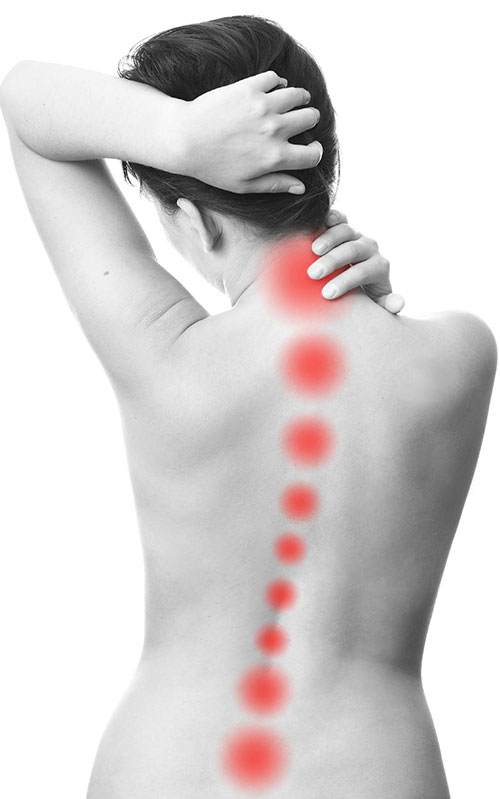What is Scoliosis?
Scoliosis is a medical condition that refers to a lateral or rotational curve and deformities in the spine. There are different types and causes of scoliosis. A congenital scoliosis is a condition that has developed after birth while an idiopathic scoliosis develops as a secondary symptom of another condition. Scoliosis can affect anyone and serious cases can be physically debilitating. Scoliosis causes the spine to develop or curve into a C-shape or into other directions. It is often painful but some conditions during adolescence not cause too much discomfort except for the obvious physical or skeletal imbalance. Celebrities who have been diagnosed with scoliosis include Isabella Rosellini, Renee Russo, Liza Minelli, and Sarah Michelle Gellar.
How to get a proper diagnosis
A chiropractor can evaluate you for scoliosis by performing the following examinations:
Physical Examination – Your doctor will check your back, chest, hips, legs, and even the skin. The doctor will look for imbalances or structural abnormalities in your shoulders, legs, and chest. Specifically, the doctor will look to see of your head is centered over your shoulders, and whether opposite sides of your body look even. Another easy way to detect scoliosis is to examine whether your pant legs drop at equal length.
X-ray – If you have unusual, persistent low back pain or a large spinal curve, the doctor will ask you to take an x-ray examination. The x-ray of your back will give a more detailed picture of the spine and the curvatures.
Curve Measurement – Using the X-ray image, the doctor will measure the curve and determine what kind of therapy or treatment is needed based on the degree of curvature. Curves that are greater than 20 degrees need immediate medical treatment, which may include surgery.
Kinds of treatment for scoliosis
There are different approaches in the treatment and management of scoliosis, as shown below:
Bracing – This is recommended for children or adolescents whose curves progress to 30 degrees and beyond. Bracing allows the spine to be held in a straighter position and prevents the progression of the curve.
A brace will not make your spine straight but it will help improve the posture and reduce the curvature. The commonly prescribed brace is called the Milwaukee Brace which consists of metal uprights attached to pads and positioned on the hips, rib cage, and neck; and the Underarm Brace which is made of plastic and is placed around the rib cage, abdomen, and hips. Bracing is also prescribed for other types of neuromuscular disease such as spinal muscular atrophy.
Surgery – When bracing fails to give the desired results, surgery is often seen as the next option. Bracing might not work for everyone. The main purpose for surgery is to join together the bones of your curve and realign the vertebrae. The surgical procedure is called spinal fusion.
Chiropractic Care with scoliosis
Normally, chiropractors look for misalignments in the spine and try to re align them to allow proper nervous system function. The major issue with scoliosis is the location of the joints. The joints of the spine need to be re-positioned first and foremost. But for any long term benefit to occur, there’s a whole lot more that needs to accompany this re-positioning. Your muscles need to be relaxed. Your brain needs to be retrained to use the muscles and spinal joints differently than it’s become accustomed to. In order for scoliosis to be effectively treated, all of these things need to be happening together. In practice, this usually means scoliosis massages, stretches and exercises along with scoliosis-specific adjustments. Miscommunication between the brain and body can lead to all sorts of issues, including scoliosis. Having misalignments in the spine doesn’t allow for the nerves to flow properly back and forth from the brain to body regions. Fixing scoliosis requires us to retrain the brain to use the body, especially the spine, in ways it’s grown unaccustomed to.
A 2011 study reviewed outcomes for adult scoliosis patients receiving chiropractic rehabilitation: A total of 28 patients fit the inclusion criteria for the study. The average beginning primary Cobb angle was 44° ± 6°. Patients received the same chiropractic rehabilitation program for approximately 6 months. At the end of active treatment, improvements were recorded in Cobb angle, pain scores, spirometry, and disability rating. All radiographic findings were maintained at 24-month follow-up (Morningstar).
Coping with scoliosis
In 90 percent of cases, scoliotic curves are mild and do not require active treatment. In the growing adolescent, it is very important that curves be monitored for change by periodic examination and standing x-rays as needed. Increases in spinal deformity require evaluation by an orthopaedic surgeon to determine if active treatment is required. To cope with scoliosis, some patients get a massage or a similar therapy session that helps improve body alignment, flexibility, and posture. Aquatic exercise can also improve a scoliosis patient’s posture and balance. Acupuncture is also used as an alternative method for reducing pain and discomfort brought about by scoliosis. Your world need not stop from spinning just because you have a spine problem. Scoliosis patients can still lead happy, active lives. People with scoliosis can still participate in sports and other physical activities. Remember, physical fitness is important for people with back and spine problems.
Morningstar MW. Outcomes for adult scoliosis patients receiving chiropractic rehabilitation: a 24-month retrospective analysis. Journal of Chiropractic Medicine. 2011;10(3):179-184. doi:10.1016/j.jcm.2011.01.006.


0 Comments